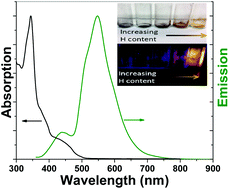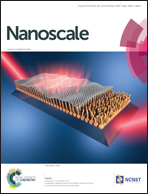Investigation of hydrogen induced fluorescence in C60 and its potential use in luminescence down shifting applications†
Abstract
Herein the photophysical properties of hydrogenated fullerenes (fulleranes) synthesized by direct hydrogenation utilizing hydrogen pressure (100 bar) and elevated temperatures (350 °C) are compared to the fulleranes C60H18 and C60H36 synthesized by amine reduction and the Birch reduction, respectively. Through spectroscopic measurements and density functional theory (DFT) calculations of the HOMO–LUMO gaps of C60Hx (0 ≤ x ≤ 60), we show that hydrogenation significantly affects the electronic structure of C60 by decreasing conjugation and increasing sp3 hybridization. This results in a blue shift of the emission maximum as the number of hydrogen atoms attached to C60 increases. Correlations in the emission spectra of C60Hx produced by direct hydrogenation and by chemical methods also support the hypothesis of the formation of C60H18 and C60H36 during direct hydrogenation with emission maxima of 435 and 550 nm respectively. We also demonstrate that photophysical tunability, stability, and solubility of C60Hx in a variety of organic solvents make them easily adaptable for application as luminescent down-shifters in heads-up displays, light-emitting diodes, and luminescent solar concentrators. The utilizization of carbon based materials in these applications can potentially offer advantages over commonly utilized transition metal based quantum dot chromophores. We therefore propose that the controlled modification of C60 provides an excellent platform for evaluating how individual chemical and structural changes affect the photophysical properties of a well-defined carbon nanostructure.


 Please wait while we load your content...
Please wait while we load your content...